
Introduction
Crude oil is considered as the most precious commodity on earth, primarily because of the important role it plays in global manufacturing activities. Oil investors should familiarize themselves with the two different variants available for investments: West Texas Intermediate (WTI) and Brent Crude. Typically, Brent oil trades at a premium to WTI crude oil. The below is an illustration of the characteristics of these two products.
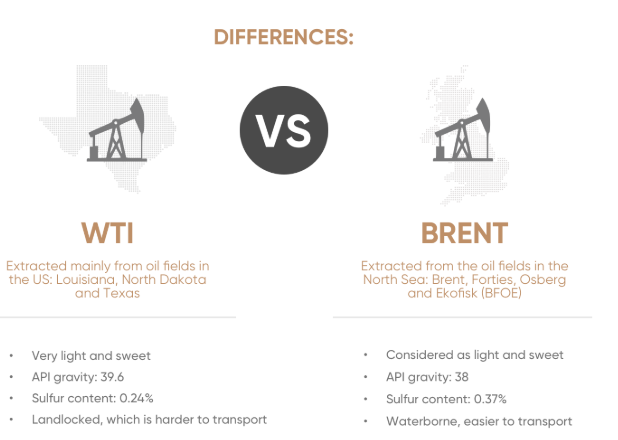
Source: Capital.com
Many investors, both experienced and novice, continuously search for the available methods to invest in oil. This article aims to serve as a complete guide that discusses all the popular ways to invest in this asset class.
Oil futures contracts
An investor can use futures contracts to gain exposure to oil, but a thorough understanding of how these financial instruments function is required before deciding to invest in oil through futures. A futures contract is a standardized legal agreement to buy or sell something at a predetermined price at a specified time in the future, between parties not known to each other. When it comes to crude oil futures, a contract represents ownership of 1,000 barrels. These contracts trade on different exchanges around the world, and below are a few of the largest exchanges where these contracts can be bought or sold.
- Chicago Mercantile Exchange
- New York Mercantile Exchange
- The Intercontinental Exchange (U.S.)
- Eurex (Europe)
- National Stock Exchange of India
Given that a single contract represents 1,000 crude oil barrels, an investor might assume that a substantial initial investment is required to buy futures contracts. This, however, is far from the truth. To open a position on any futures contract, an investor is only required to layout a very small investment, which is referred to as the initial margin.
Here is an example of how futures contracts work.
If a barrel of WTI crude oil is trading at $50, the notional value of the contract comes to $50,000. If the initial margin requirement of the exchange is 5%, an investor only needs to put in $2,500 to buy one futures contract.
Generally, the initial margin requirement is set at a very low level to enable traders to reap the best rewards from these contracts. As we can see from the above example, these contracts allow an investor to use a considerable amount of leverage, which can be both good and bad.
Here are the advantages and disadvantages of investing in oil through futures contracts.
|
Advantages |
Disadvantages |
|
Futures contracts are very liquid, making it easy to buy and sell these products with little-to-no hassle. |
Every futures contract comes with an expiration date, and an investor needs to keep a tab of these dates to either roll over the contract to the next month's futures or to exercise them before the expiry date. |
|
The high level of leverage used in these contracts allows an investor to make substantial profits. |
Futures prices become very volatile due to various external developments including but not limited to macro-economic developments and geopolitical issues. This volatility can lead to massive losses for untrained investors. |
|
The trading of these contracts is widely available through both online and offline brokers. |
Investors and traders need to use futures contracts cautiously to mitigate the risks while gaining exposure to this lucrative asset class. A classic example of the riskiness of these instruments is how futures prices went into negative territory for the first time in history on April 20.
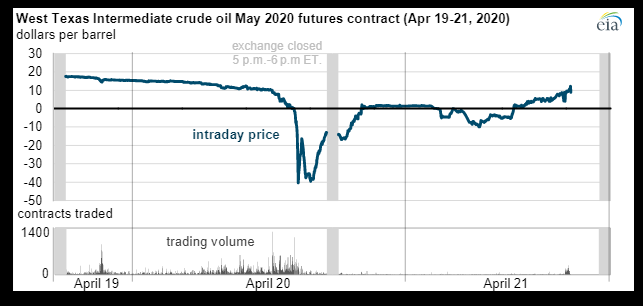
Source: Energy Information Administration
When this happened, many investors not only lost their initial capital outlay but also had to repay their brokers massive amounts of money as well to cover for their positions that were initiated on margin (leverage). Many of these investors were not aware of how futures work and obtaining a thorough understanding of the dynamics behind these instruments is paramount to the success of an investor.
Oil CFD instruments
Contracts For Difference (CFD) are financial instruments that enable an investor or trader to use substantial leverage to invest in equities, commodities, and currencies. A thorough understanding of how futures contracts work is necessary to identify the underlying pricing mechanism of CFDs.
CFDs function very similar to futures contracts, but there is one difference that sets them apart. A buyer of a futures contract can exercise the instrument before its expiry date and the seller of the contract is obliged to deliver the specified amount of crude oil barrels to the buyer at the price specified in the contract terms. Therefore, these are used by many major oil companies to hedge their price risk. In contrast, a CFD is only a trading instrument that is designed to track the performance of various financial instruments, including crude oil. It’s critical to understand that these CFDs do not provide an investor with any ownership of a company, commodity, or currency. Rather, a CFD allows an investor to use leverage to benefit from the price movements of various securities.
An investor can use the below illustration to understand the primary differences between futures contracts and CFDs.
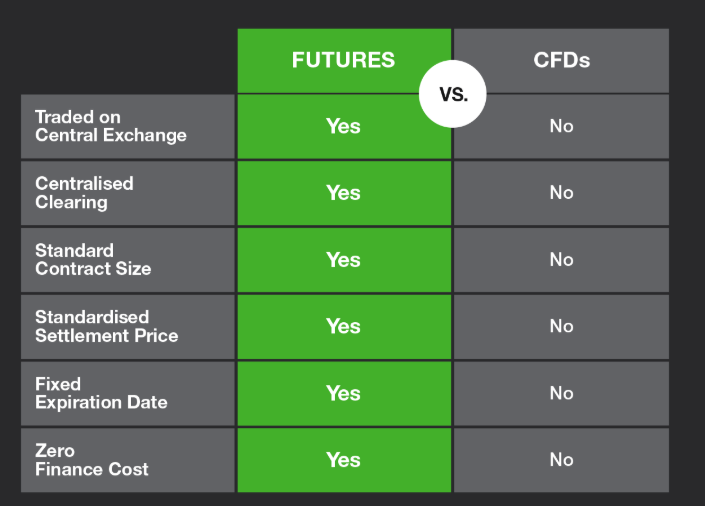
Source: TD Ameritrade
Most investors assume that buying a CFD gives them ownership of the underlying asset, which is not true. Therefore, an investor who uses CFDs to invest in oil does not really own any physical oil, which is one of the primary risks of using this financial instrument.
Similar to futures contracts, the primary advantage of using CFDs is the ability to use leverage. In fact, CFDs are considered as the riskiest financial instruments available in the market, and it’s reasonable to conclude that retail investors who are not trained in using these instruments should look for alternative methods to invest in oil.
Investing in equity securities of publicly listed oil companies
Investing in shares of energy companies is one of the most popular ways of betting on oil. This is also one of the safest ways to invest in oil as an investor can diligently select the best companies operating in this industry to mitigate the risks.
First, investors need to get a clear idea about the different types of oil companies that are trading on equity markets around the world. There are primarily three types of companies.
- Upstream companies
- Midstream companies
- Downstream companies
In short, a company is categorized based on the value chain positioning of that company. Below is an illustration of these three categories which should help an investor understand the big picture better.
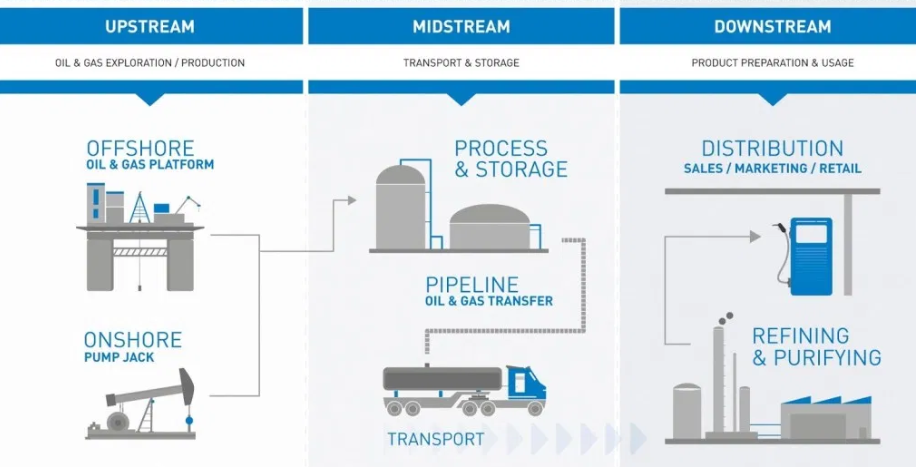
Source: Aavos International
Today, many of the largest oil companies are classified as integrated oil and gas companies, meaning these companies conduct business operations in all of the three business categories that we identified above. Below is a list of the largest integrated oil companies in the world.
|
Company name |
Stock ticker |
|
China Petroleum & Chemical Corporation |
NYSE: SNP |
|
Royal Dutch Shell |
AMS: RDSA |
|
China National Petroleum Corp |
SHA: 600028 |
|
BP Plc |
LON: BP |
|
Exxon Mobil |
NYSE: XOM |
|
Total |
NYSE: TOT |
|
Chevron |
NYSE: CVX |
|
Rosneft |
MCX: ROSN |
|
Lukoil |
MCX: LKOH |
|
Phillips 66 |
NYSE: PSX |
It’s easier to invest in a large integrated company as these are leading players of the industry and benefit from various competitive advantages resulting from their massive scale. However, investing in pure-play upstream, midstream, or downstream companies is a much more complicated task, and investors need to have a thorough understanding of a few key points to be successful.
Upstream oil companies are price takers and their profitability is closely tied to the market rates for oil. Therefore, the share price of these companies tends to fluctuate widely when crude oil prices are volatile. Because of this inherent risk in this sector, an investor needs to carefully vet for upstream companies in good financial health. Another important consideration is the cost structure of a company. Empirical evidence obtained from Eikon suggests that upstream companies with poor cost structures tend to go out of business during energy market crashes. The best course of action for an investor is to compare the operating profit margins of companies in this sector to identify the cost-leading companies.
Below is a list of upstream companies to consider investing in.
- ConocoPhillips (NYSE: COP)
- Schlumberger (NYSE: SLB)
- EOG Resources (NYSE: EOG)
- Suncor Energy (NYSE: SU)
- Occidental Petroleum (NYSE: OXY)
The midstream sector, as the name suggests, is in the middle of the value chain. These companies play an important role in the energy industry by acting as the middleman that facilities the business operations of upstream and downstream companies. One of the most unique characteristics of companies operating in the midstream sector is that they generate billions of dollars in free cash flow, enabling them to pay substantial dividends compared to other energy companies.
Some of the largest midstream companies include:
- Enbridge (NYSE: ENB)
- Energy Transfer (NYSE: ET)
- Enterprise Product Partners (NYSE: EPD)
- Kinder Morgan (NYSE: KMI)
- Williams Companies (NYSE: WMB)
Investing in the downstream sector is intrinsically different from the other two sectors. While upstream companies benefit from higher oil prices, downstream companies are positioned to perform well under depressed oil prices as well. This is because most downstream companies use crude oil as a raw material to produce its final products, and when the crude oil price is low, the margin that could be charged for their end products become higher as there is often a time lag between the decline in prices of crude oil and refined products.
Below is a list of leading publicly listed downstream companies.
- Marathon Petroleum (NYSE: MPC)
- Valero (NYSE: VLO)
- CVR Energy (NYSE: CVI)
- AmeriGas Partners (NYSE: APU)
- Sunoco (NYSE: SUN)
An investor might wonder why investing in equity securities of energy companies is one of the safest ways to bet on this industry. There are various reasons for this.
First, when an investor purchases shares of a company, he or she becomes an owner of the underlying company behind the securities. This distinguishes stock market investments from other popular methods such as futures and CFDs. Also, as an owner of a company, investors are entitled to receive dividends as and when they are declared by companies. The good thing is that energy stocks usually trade at market-leading dividend yields. Even after the global market turmoil and the challenges faced by the energy industry in the last couple of months, this sector has the highest dividend yield among all sectors represented by the S&P 500 index (data as of May 13).
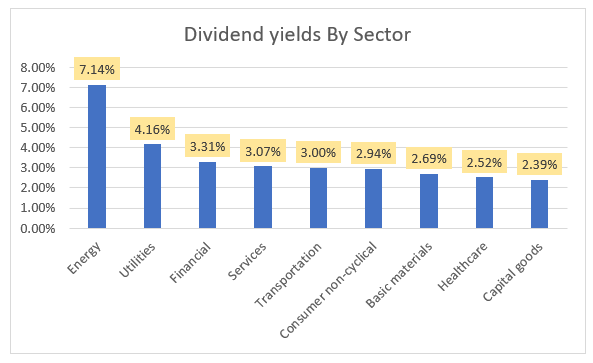
Source: Eikon
Second, share prices of energy companies are much less volatile than futures or CFDs, which makes them a better option for risk-averse investors and long-term oriented investors.
Third, shares of energy companies have closely tracked crude oil prices in the past, which makes it one of the most reliable investments to track long-term trends in the price of oil. For example, Royal Dutch Shell shares have exhibited a very high correlation of above 0.6 with crude oil consistently in the last 5 years.
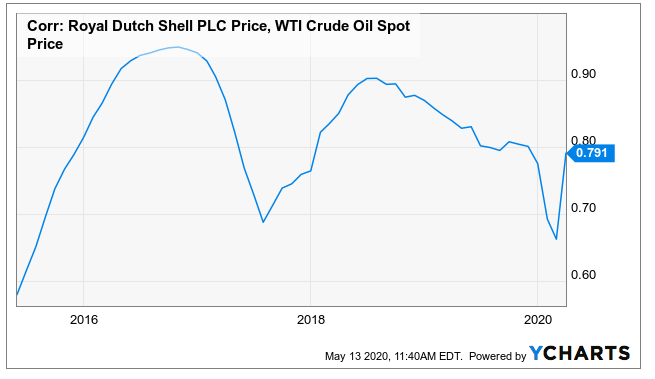
Source: YCharts
The same is true for many other large oil companies as well.
Taking all these characteristics into consideration, it’s reasonable to conclude that investing in the shares of energy companies is a reliable way of investing in oil.
Exchange-traded funds
Over the last decade, exchange-traded funds (ETFs) have become a mainstream product in financial markets around the world. Today, ETFs can be used to invest in various asset classes across the board. Once again, an investor needs to realize that owning an ETF is an indirect way of investing in oil as the investor would not be investing in physical oil. There are two types of oil ETFs.
- Funds that invest in the shares of oil companies
- Funds that invest in futures, options, and forward oil contracts
An investor can directly invest in all these types of securities as well but there are a few advantages of doing this through an ETF.
The primary benefit is the expertise brought to the table by fund managers employed by ETF providers. If an investor wanted to buy the shares of an energy company or invest in futures contracts, the entire due diligence and analyzing process should be completed by the individual. On the other hand, many retail investors are not in a position to hire a qualified investment manager as well because of the significant costs involved with that. By investing in oil ETFs, an investor can find a reliable answer to this problem as ETFs are provided by the world’s largest asset management companies such as BlackRock and Vanguard, and these trillion-dollar asset managers employ the best brains in the industry to manage their funds, including oil ETFs. Therefore, an investor can obtain the services of these qualified fund managers at a fraction of the cost by investing in an oil ETF.
Another benefit of using an ETF to gain exposure to the oil industry is the diversification benefits that come along with funds. Because ETFs invest in a large number of stocks or futures contracts, an investor can easily diversify his portfolio by investing in a single fund.
Finally, ETFs provide tax advantages over mutual funds, which should be a reason for mutual fund investors to reconsider their strategy. Due to structural differences, mutual funds typically incur more capital gains taxes than ETFs. Moreover, capital gains tax on an ETF is incurred only upon the sale of the ETF by the investor, whereas mutual funds pass on capital gains taxes to investors through the life of the investment.
Below are some of the most liquid oil ETFs to consider.
- Energy Select Sector SPDR Fund (XLE)
- iShares Global Energy (IXC)
- United States Oil Fund (USO)
- Invesco DB Oil Fund (DBO)
- Vanguard Energy ETF (VDE)
In addition to buying oil ETFs, an investor can buy funds that track the economic performance of oil-producing countries. There are a few countries that depend on crude oil production and exports, and the economic growth of such countries depend on the price level of crude oil and the demand for oil in the open market. Because of this characteristic, country ETFs of these nations tend to fluctuate with the price of oil. Below are some of the country ETFs an investor can consider.
- iShares MSCI Mexico ETF (NYSEARCA: EWW)
- Franklin FTSE Russia ETF (NYSEARCA: FLRU)
- iShares MSCI Saudi Arabia ETF (NYSEARCA: KSA)
The low costs involved with all these funds make oil ETFs an attractive choice for all investors alike.
Buying currencies of oil-producing countries
So far in this analysis, we have discussed all the popular ways of investing in oil. However, there is one other mechanism that could be used to gain exposure to movements in crude oil prices: investing in currencies of major oil-producing countries.
Petrocurrencies is a popular term used to describe the currencies of major oil-producing nations. Even though Saudi Arabia, the United Arab Emirates, and many other Middle Eastern countries are leading oil producers, all these countries have pegged their respective currency to the U.S. dollar in a bid to mitigate wild fluctuations of the value of their currencies. Therefore, petrocurrencies do not include any of these currencies.
There are 5 major currencies recognized as petrocurrencies because of the dependency on crude oil exports.
- Norwegian krone
- Canadian dollar
- Columbian peso
- Russian ruble
- Mexican peso
For a brief period in 2015 and 2016, these currencies exhibited a very low correlation with crude oil, which came as a surprise. However, since then, the normalcy has prevailed. In 2019, the correlation of these currencies with the price of crude oil restored to their normal levels, which is depicted in the below chart.
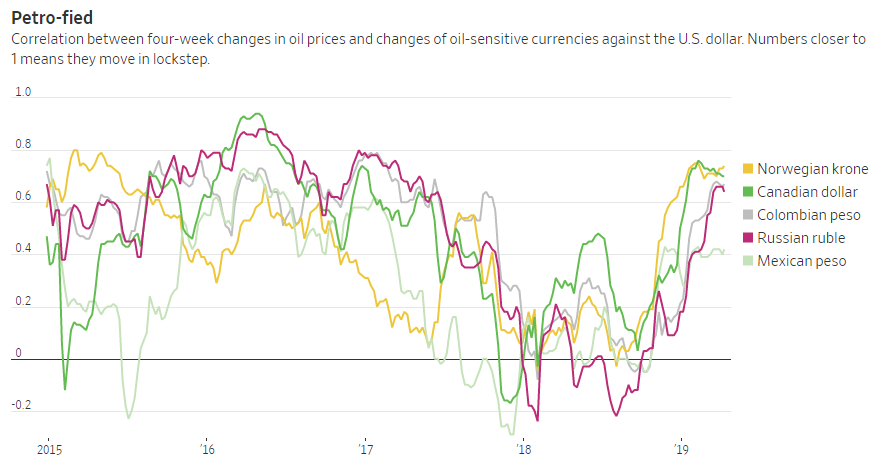
Source: The Wall Street Journal
A prudent investor who understands this relationship can bet on these currencies when the outlook for crude oil is positive, and short these currencies when the outlook is bleak.
Even though this strategy is not widely used by retail investors, professional and institutional investors often use currency strategies to bet on the price movements of oil and other commodities.
Risks of investing in oil and ways to mitigate such risks
Every investment carries risk, and there are no exceptions for crude oil as well. Regardless of the chosen method, an investor will always be exposed to geopolitical risk when investing in oil. The oil price war between Saudi Arabia and Russia that escalated last March serves as a classic example of this risk.
Adverse macro-economic developments will also impact the price of oil negatively. For instance, during global recessions, the price of a crude oil barrel tends to decline drastically as global business activities come to a standstill.
It might seem that mitigating the risks of investing in oil is an improbable task. It surely is a difficult task, but not an impossible task. The best course of action is to thoroughly identify the dynamics driving oil markets before reaching any investment conclusion. Often, such analyses help in uncovering catalysts that could drive oil prices higher or lower in a given time period. Taking a long-term position is also another proven way to mitigate the risks of investing in oil. Even though oil prices will fluctuate wildly in the short to medium term, in the long run, oil prices will only head higher. The International Energy Agency projects the price of a Brent Crude oil barrel to surpass $100 by 2030.
Conclusion
Commodities play an integral part in portfolio diversification, and we have outlined various ways an investor can gain exposure to crude oil. Empirical evidence suggests that investing in oil will not only provide stellar returns in the long term but also provide portfolio diversification benefits. The decision to use a specific strategy outlined in this article to invest in oil should be based on the investment objectives, investment time horizon, and the risk tolerance of an individual. When an investment in oil is executed correctly, an investor stands to realize substantial returns in the long run.
